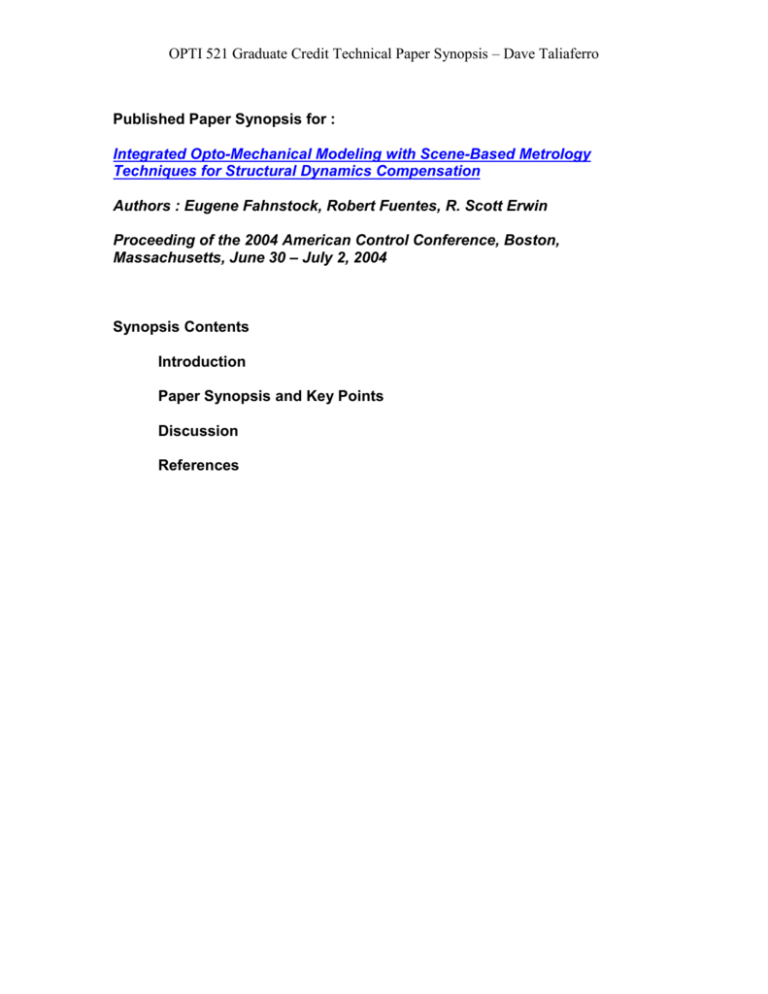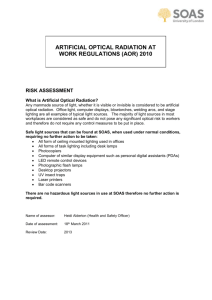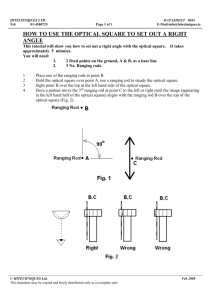Published Paper Synopsis for : - The University of Arizona College
advertisement

OPTI 521 Graduate Credit Technical Paper Synopsis – Dave Taliaferro Published Paper Synopsis for : Integrated Opto-Mechanical Modeling with Scene-Based Metrology Techniques for Structural Dynamics Compensation Authors : Eugene Fahnstock, Robert Fuentes, R. Scott Erwin Proceeding of the 2004 American Control Conference, Boston, Massachusetts, June 30 – July 2, 2004 Synopsis Contents Introduction Paper Synopsis and Key Points Discussion References OPTI 521 Graduate Credit Technical Paper Synopsis – Dave Taliaferro Introduction This report for OPTI 521 Introductory Opto-Mechanical Engineering presents a synopsis of a published paper relating to the broad topic of integrated opto-mechanical modeling. For brevity, the paper being reviewed here will be referred to as the Fahnstock paper. The Fahnstock paper presents a summary of integrated opto-mechanical analysis using statespace and linear optical modeling concepts, and reviews an example of practical work using various engineering software packages, as well as Zelink, a custom optical modeling tool. As a summary of concepts and techniques, the Fahnstock paper covers a lot of material in a few pages. The technologies described encompass linear optical modeling, state-space structural and optical sensitivity analysis, and aberration compensation techniques using phase-diversity algorithms. Those techniques are described more thoroughly in the references, some of which are provided with this report. To meet the second requirement for this assignment, a tutorial on using Zelink to model optical system wavefront error due to structural vibration will be presented. This technique is based exactly on the methods described in the Fahnstock paper, as one of the paper’s co-authors, Robert Fuentes, has fortuitously asked me to perform this analysis at the time this report was due for OPTI 521. The tutorial will be provided as a separate document. Paper Synopsis and Key Points Synopsis The Fahnstock paper presents a summary of integrated opto-mechanical analysis and control system design using state-space and linear optical modeling concepts, and reviews an example of practical work using various engineering software packages, as well as Zelink, a custom optical modeling tool. The problem described in the paper is that of modeling a control system based on surface variations of a reflecting telescope mirror from piezoelectric actuator influences that have resultant effects on optical properties such as line-of-sight, wavefront error, and image phase-diversity, which are then used to provide feedback to the control system. The paper focuses on the use of sensitivities to map from structural deformation to optical properties, which is achieved through the use of Zemax coupled with Simulink through the Zelink interface tool. Additionally, a method of object image generation based on the derived system optical aberrations, and the generation of a second image by adding a defocus term for subsequent phase-diversity analysis is discussed. Finally, an overview of a control system architecture that uses the phase-diversity results as feedback to the control gain is presented. The key result of this analysis and modeling effort is quantitative optical property information from opto-mechanical disturbances to the controlled telescope, which aids in further design refinement. OPTI 521 Graduate Credit Technical Paper Synopsis – Dave Taliaferro This is crucial for development of space-borne systems, which have stringent requirements for structures, size, weight, and motion sensitivity. A limitation to the integrated modeling approach is the computational complexity, and the difficulty in implementing the real-time control system on actual hardware because of algorithm processing demands. To this end, significant work is being done to realize the processing hardware functionality by using FPGA technology for phase-diversity and control loop implementation. These techniques are not addressed in Fahnstock’s paper but are the natural follow-on discussions. Key Points Actuator-Structure Modeling Using State Space Representation The model begins with a Schmidt-Cassegrain scope optical prescription in Zemax. The Zemax optical surfaces were exported in CAD format to finite element modeling tools to create a structural FE model of the surfaces and to obtain the non-rigid body modal frequencies and accompanying mode shape displacements at the nodes of interest, which are the mirror vertex nodes and the actuator endpoints. The displacements on the mirror vertex nodes, the actuator endpoints, and the actuator force components were assembled into matrices to obtain the state-space representation of the system, which was then converted to a set of discrete first-order differential equations for use in a control system simulation using Simulink. The result is a state-space representation of the telescope mechanical structure, including the optical components, which can then be used with linear analysis techniques to determine disturbance effects on optical performance. Generation of Optical Quantities of Interest Optical quantities of interest such as wavefront error and optical path difference (OPD) are generally non-linear due to the combination of geometric and diffraction effects. The method outlined in the Fahnstock paper obtains the OPD at the pupil plane, thus reducing non-linearity by maintaining diffraction-limited criteria. The OPD information is then linearized through Zernike decomposition and assembled into a matrix for linear analysis. Geometric Effects and Derivation of Sensitivities Modeling of the non-linearities through ray-tracing can be done with standard optical design software but is computationally intensive. The approach to this problem in the Fahnstock paper is to use linearized optical sensitivities to map structural deformations to optical properties. This technique is described in the attached references by Redding. To derive the sensitivities, Zemax was used with the Zelink tool to build a simulation that fed a ramp signal to the mechanical DOFs of the telescope mirrors, generating OPD maps as a function of perturbation values. To represent the OPDs by linear approximation, the Zernike standard polynomials were calculated for coordinates inside the pupil plane aperture and assembled into a matrix to obtain the coeffecients for the expansion of the OPD surface. Finite differencing was then used to OPTI 521 Graduate Credit Technical Paper Synopsis – Dave Taliaferro provide sensitivity values for each coefficient with respect to the motion of a particular mechanical DOF. The quality of the derived sensitivity matrix was analyzed by comparing to OPD generated by Zelink against the sum of the products of the column vector of instantaneous mechanical DOF perturbations and each row from the sensitivities matrix and the corresponding Zernike polynomial basis function. The OPD and the Zernike results were reshaped into 2D image arrays for visual comparison. RMS errors between OPDs generated by Zelink and those generated by the linear sensitivity method were compared, demonstrating very slight errors between the two approaches. Diffraction Effects and Image Computation The OPD map at the pupil plane represents all the optical aberrations for a diffraction-limited system. The Fahnstock paper describes briefly how the complex coherent transfer function can be obtained from the OPD using the Zernike shape function and the pupil geometry. Taking the autocorrelation of the complex coherent transfer function yields the complex optical transfer function (OTF), which can then provide a spatial image via the Fourier Transform. The key point here is that by adding an additional aberration to the image in the form of defocus, a second image can be produced for use with a phase-diversity algorithm to perform feedback control of the telescope from information obtained by disturbances to the structure. Phase Diversity Algorithm Phase diversity uses the nominal image along with a second image containing a small amount of defocus (for example) to determine perturbation effects on an optical system by examining the image effects rather than by direct measurement of the aberrations. Defocus is most commonly used because it is easy to implement mechanically. The key usefulness of the phase-diversity approach is that it relies on image information instead of physical measurement, and the image information obtained is also scene-independent, meaning that it does not depend on a particular type of scene or image. From the two images generated through the method described in the paper a feedback variable was produced for use in the telescope control system. The problem in this approach, mentioned earlier, is the computational cost of real-time processing the phase diversity algorithms. This will eventually be overcome as computing technology advances. Control Architecture The final section of the Fahnstock paper discusses the application of the actuator disturbance analysis and phase-diversity algorithm in the telescope control system. The control system was modeled in Simulink with the addition of the mechanical DOF sensitivity matrices and a phasediversity block, with the intent to drive the wavefront error to zero by compensating the actuators using the phase-diversity feedback. The simulation results indicated good control stability, and the elimination of image distortion. OPTI 521 Graduate Credit Technical Paper Synopsis – Dave Taliaferro Discussion The applicability of the methods described in the paper to various optical control system problems, as well as disturbed optical system performance, among others, is potentially widespread. Additionally, the methods have been employed by other researchers using different software tools but with the same theoretical background and interpretations. The main problem at the moment for interested researchers is the scarcity of tools for performing the modeling effort; specifically tools for integrating optical design software with finite element and control system simulation software. Most of the publicized work in this arena has been done for fairly large modeling efforts for space telescopes, and the associated tools are expensive or difficult to obtain. Other publications on this topic mention in-house developed tools that are not commercially available. The Zelink tool described in the paper has been used successfully for use in these types of analyses at Boeing-SVS, where it was developed by Karl Schrader. Unfortunately it is also not commercially available at this time, though some effort has been made to make it available to university researchers. The Fahnstock paper describes an optical control system implementation through modeling of aberrations caused by structural disturbances. It is presented as a survey, and as such covers a lot of territory for a short paper. To readers unfamiliar with the various techniques, it can be a daunting amount of information to understand. To illuminate the ideas from a practical perspective, the second part of this OPTI 521 graduate credit assignment will provide an in-depth tutorial on using Zelink to model the effects of structural disturbances to wavefront error, based on the methods describe in Fahnstock’s paper. Extensive background information in the form of references for various pertinent topics will also be provided with that tutorial. OPTI 521 Graduate Credit Technical Paper Synopsis – Dave Taliaferro References Some relevant references are provided with this synopsis. A more complete reference list will accompany the tutorial requirement for this assignment. Books (look on Amazon.com for information) : Theory of Matrix Structural Analysis, by J. S. Przemieniecki Introduction to Dynamics and Control of Flexible Structures, by John L. Junkins, Youdan Kim Integrated Optomechanical Analysis, by Keith Doyle, Victor Genberg, Gregory Michels, http://www.sigmadyne.com/sigweb/pubs.htm Linear Optical Modeling : Redding, D., Breckinridge, W., Optical Modeling for Dynamics and Control Analysis, 1991; Guidance, Navigation and Control Conference, Portland, OR, 1990 Technical Papers, American Institute of Aeronautics and Astronautics Redding, D., Millman, M., Loboda, G. Linear Analysis of Opto-Mechanical Systems, Proceedings of SPIE -- Volume 1696 Controls for Optical Systems, July 1992, Integrated Optical Modeling : Steve Griffin, Karl Schrader, Boeing-SVS, Modeling Dynamic Optical Systems, SPIE tutorial with some limited discussion of Zelink. Schipani, P., Perrotta, F., Marty, L., Integrated modeling approach for an active optics system, Proceedings of SPIE -- Volume 6271 Modeling, Systems Engineering, and Project Management for Astronomy II, 627116 (Jun. 23, 2006) Phase Diversity These sites have good theory and links to phase diversity papers http://waf.eps.hw.ac.uk/index.htm http://www.optics.rochester.edu/workgroups/fienup/Publications.htm Piezoelectrics Good piezo tutorial : http://www.physikinstrumente.com/en/products/piezo_tutorial.php State-space Systems : Good state-space tutorials : http://cnx.org/content/col10143/1.3 http://www.duke.edu/~hpgavin/ce131/






